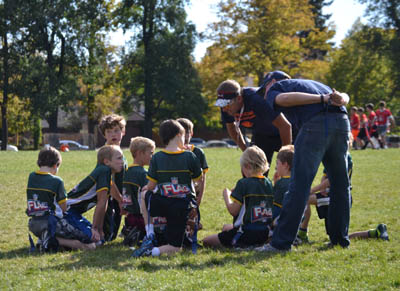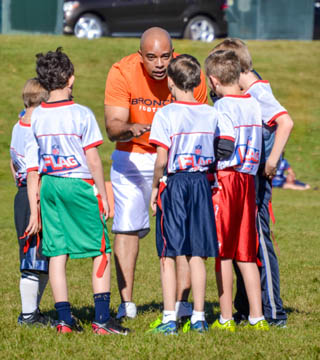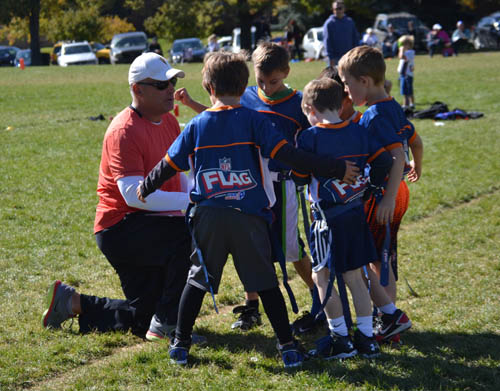Young players have short attention spans and can get bored very easily. To prevent this, it's important to have a well-designed practice plan that will keep players active throughout the practice session. To ensure practice is run effectively, avoid having players standing around and waiting for something to do.
 When a drill ends, be ready to quickly move on to the next one. Also, keep in mind that trying to introduce the technical aspects of passing, running and defense in a conventional manner probably won't work well with young kids. It's best to tailor practice plans and make them age-appropriate.
When a drill ends, be ready to quickly move on to the next one. Also, keep in mind that trying to introduce the technical aspects of passing, running and defense in a conventional manner probably won't work well with young kids. It's best to tailor practice plans and make them age-appropriate.
Practice Tip: While having a practice plan is important to stay focused and organized, some drills may not work well for your team. A drill may be too difficult, too easy, or too boring for your team. Each team is different. When planning a practice, have a few extra drills ready to be used in place of a drill that’s not working.
Again, a great way to keep players engaged is is to keep them moving and involved. If possible, have all your players performing the drill at the same time. Limit the amount of time a player is watching other players perform - that's the time you are most likely to lose them.
To keep practice interesting and fun for your players, each drill should be no more than 5-10 minutes. After that time, switch drills. Try having your team run to another section of the field to begin the new drill - this introduces change, helping to keep players engaged and limits the chance for players to get bored. In time, you'll get a feel for your team’s attention span and adjust the length of each drill accordingly.
Practice Goals
 It’s great to establish goals for each practice. Share your goals with the assistant coaches, parents and most of all the players right at the beginning of practice. Don’t overwhelm your players with a large number of goals for each practice. Even if you want to accomplish many things in practice, designate a few as “practice goals”. Remember, for many players this may be their first experience with flag football. Take care not to overwhelm them.
It’s great to establish goals for each practice. Share your goals with the assistant coaches, parents and most of all the players right at the beginning of practice. Don’t overwhelm your players with a large number of goals for each practice. Even if you want to accomplish many things in practice, designate a few as “practice goals”. Remember, for many players this may be their first experience with flag football. Take care not to overwhelm them.
Examples of Practice Goals
“Execute 2 offensive plays properly”
“Defenders - Get in the proper position to grab a flag”
The one goal that should be consistent for each and every practice is TO HAVE FUN!!
Practice Components
Practices should have a few components that should remain consistent throughout the season, though the practice drills should vary so that players don't get bored and lose interest.
Pre-Practice Talk
Before practice begins, let your players know what you'll be doing during the practice. Quickly tell them the drills they'll perform, what is expected from them, and the goals for the practice. Have the parents listen to the Pre-Practice Talk so that they know what will be going on.
Warm-up/Stretching& Conditioning
It’s very important to have a short warm-up at the start of the practice. The warm-up should consist of stretching and some light cardio exercises. Stretching will help loosen tight muscles and help prevent muscle injuries.
Fundamental Skills and Position Drills
In this portion of practice you will teach your players the fundamental skills needed to play flag football. These drills can consist of:
- Running Drills
- Passing Drills
- Defensive Drills
- Coordination Drills
Have all your players involved with drills at the same time to keep them engaged
 Game Situation Drills
Game Situation Drills
Many coaches will say that “The only way you learn the game is by playing the game”. This may be true for older kids, but for young and first time players, even the flag football basics may be a challenge. Think of Game Situation Drills as small, manageable portions of games that concentrate on the development of a couple of core skills. Again, remember to try to keep all the players active during the drills.
Practice Games/Scrimmages
Practicing fundamentals and station drills all the time may grow tiresome to young players – they want to play. Divide your players into two groups and scrimmage among yourselves. Observe all the rules of a league game, but frequently stop the action to provide the team with tips, strategy and additional instruction.
Post Practice Talk
In this short conversation at the end of the practice session, go over what the team has accomplished and reinforce the key concepts you want them to take away from the practice. This is a great time to compliment the team and let them know how well they have performed.
Breaks
Have frequent water breaks during practice, especially in hot weather. For young players, it’s a
good practice to have a water break every 15-20 minutes. If you divide your practice into four quarters, take a break after every quarter.
Communication – Keep it Simple
When explaining flag football fundamentals, don't get too technical, especially with younger kids. Teach the basics, but do it in a way so that THEY understand. If you explain a drill or concept three times to your team and they still don’t understand it, YOU are explaining it wrong. Try another tactic. Speak with your players at a level they can understand.
The importance of clear communication with your players cannot over-emphasized. DO NOT assume they know what you are talking about. Clearly explain what the players will be doing before each drill. Ask them if they understand. You may even ask them to repeat your instructions to be sure. If players have that “fogged over” look on their faces, they probably don't get it - explain it again and ask if they have any questions about what they're supposed to be doing.